Abstract: David Calabro explores what he describes as the “divine handclasp” in the Hebrew Bible. The term refers to a handclasp between God and his human servant that had a place in ancient Israelite temple worship. Calabro indicates it was a ritual gesture that was part of temple rite performance with a priest acting as proxy for God in close interaction with mankind. While other scholars have suggested the gesture was indicative of deity transporting mankind to “glory,” Calabro’s research proposes the clasping of right hands while facing one another was ritually indicative of God granting access to His chosen rather than transporting him.
[Editor’s Note: Part of our book chapter reprint series, this article is reprinted here as a service to the LDS community. Original pagination and page numbers have necessarily changed, otherwise the reprint has the same content as the original.
See David Calabro, “The Divine Handclasp in the Hebrew Bible and in Near Eastern Iconography,” in Temple Insights: Proceedings of the Interpreter Matthew B. Brown Memorial Conference, “The Temple on Mount Zion,” 22 September 2012, ed. William J. Hamblin and David Rolph Seely (Orem, UT: The Interpreter Foundation; Salt Lake City: Eborn Books, 2014), 25–66. Further information at https://interpreterfoundation.org/books/temple-insights/.]
The topic of this paper is the form and meaning of a gesture mentioned in the Hebrew Bible: a handclasp exchanged between God and his human servant, a gesture I refer to as the “divine handclasp.”1 Taken together with comparative evidence, the contexts in which this gesture [Page 38]occurs suggest that it had a place in ancient Israelite temple worship, perhaps as a ritual gesture performed with the help of a priest who stood as proxy for God.2 Whether or not a concrete gesture is described, biblical references to the divine handclasp are profound expressions of close interaction with Deity, a concept that was rooted in the rites of the temple.
The divine handclasp has been interpreted in various ways. Mitchell Dahood considers it a means of reception into the divine council and ultimately of assumption into eternal life.3 John Eaton posits that it refers figuratively to God’s favor and aid rendered to the king during his reign.4 Both of these ideas are picked up by Othmar Keel, who further suggests that the divine handclasp was part of an ancient Israelite coronation ceremony like those of Egypt and Mesopotamia.5 Implicit in many of the suggestions on the meaning of this gesture are assumptions about the gesture’s form, such as the direction in which the participants face and whether the right or left hands are used. For example, in their discussions of the divine handclasp, both Eaton and Keel refer to a Hittite relief showing a god leading a king by the hand.6 In this relief, the god’s left hand grasps the king’s right, and the king faces the same direction as the god (see illustration and discussion below). Accordingly, the interpretations of Eaton and Keel presuppose that biblical references to God grasping the king’s hand refer to leading by the hand.
My purpose in this paper is to investigate what we can responsibly say about this gesture’s form and meaning based on the biblical texts in which it is mentioned and on a comparison of these texts with Near Eastern iconography. I will begin by reviewing the eleven occurrences of this gesture in the Hebrew Bible and pointing out clues to the form of the gesture in these passages; I will then review the evidence from iconography. After we have established the form of the gesture to the extent possible, I will conclude with some observations about what this implies for the meaning of the gesture.
Clues to the Gesture’s Form from Textual Sources
The divine handclasp is mentioned twice in the Psalms using the Hebrew verb ʾḥz, meaning “grasp.”7
| Psalm 73:23-24 | I am with you always; you have grasped my right hand [ʾḥzt byd-ymyny]. You guide me with your counsel and will afterwards receive me to glory.8 |
| [Page 39]Psalm 139:9-10 | I will ascend with the wings of dawn, I will dwell at the distant horizon of the sea. / Even there your hand will guide me, your right hand will grasp me [wtʾḥzny ymynk]. |
The fact that the gesture in both of these passages is parallel to a verb of motion (hnḥh—“lead, guide, conduct”) has led most interpreters to assume that the gesture is one of leading by the hand. This is especially clear in Dahood’s translation of Psalm 73:24: “Into your council lead me, and with glory take me to yourself.”9 However, as will be shown below, comparison with other passages argues against this interpretation and causes us to reevaluate the meaning in these Psalms passages. Both Psalm 73 and Psalm 139 happen to have thematic and linguistic connections to wisdom literature,10 and from this perspective, one might suggest that rather than referring to physical motion, hnḥh has the sense of “instruct,” as it sometimes does in Proverbs.11 The parallelism would then call attention not to the gesture’s function of transporting the Psalmist, but to its function as a means of imparting knowledge. The symbolism of God’s hand as an agent of instruction can be found elsewhere in the Psalms and in other parts of the Hebrew Bible (see Psalm 45:5; Job 27:11; Isaiah 8:11; see also Psalms 18:34; 144:1).
As Matt Brown has noticed, if we conflate the gestures in Psalm 73 and Psalm 139 (as the contextual similarity between the two verses encourages us to do), we see that both God and the Psalmist use their right hands.12 This would suggest that the participants in the gesture are facing each other, as we do when we shake hands. In contrast, leading by the hand, both in ancient iconography and in usual practice today, is similar to walking side-by-side, with one participant grasping the adjacent hand of the other.
We turn now to four passages in the latter part of Isaiah that describe the divine handclasp using the verb hḥzyq, meaning “grasp.”
| Isaiah 41:9 | I who have grasped you [hḥzqtyk] from the ends of the earth and have called you from its corners, and have said to you, “You are my servant. I have chosen you and have not forsaken you.” |
| Isaiah 41:13 | For I am Yahweh your God, he who grasps your right hand [mḥzyq ymynk], who says to you, “Do not fear, I will help you.” |
| Isaiah 42:6 | I am Yahweh. I have called you in righteousness, and I will grasp your hand [wʾḥzq bydk], watch over you, and make you a covenant of the people, a light to the nations. |
| [Page 40]Isaiah 45:1 | Thus says Yahweh to his anointed one, to Cyrus, whose right hand I have grasped [hḥzqty bymynw] to subdue nations before him, ungirding kings, and to open the doors before him, the gates not being closed. |
The context in these passages has to do with entering into a covenant, which includes an oath made by Deity. In Isaiah 45:1, the content of the oath is mentioned in connection with the gesture. The text might more clearly be translated, “whose right hand I have grasped (in oath, swearing) to subdue nations before him.” Again, this tends to invoke a handclasp between parties facing each other, such as when we clasp hands to strike a bargain.
A fifth example belonging to the prophetic genre is found in Jeremiah 31:31–32.
| Jeremiah 31:31-32 | Behold, days are coming, says Yahweh, that I will make a new covenant with the house of Israel and with the house of Judah, / not like the covenant that I made with their ancestors in the day that I grasped their hand [hḥzyqy bydm] to bring them out of the land of Egypt, which covenant of mine they broke, though I had become their husband, says Yahweh. |
This passage, like those from Psalms 73 and 139 above, has often been misinterpreted as referring to leading by the hand. However, the context here in Jeremiah 31:31–32 refers to a covenant, and the clause in question may be rendered as “I grasped their hand (in oath, swearing) to bring them out of the land of Egypt,” like the clause “whose right hand I have grasped (in oath, swearing) to subdue nations before him” in Isaiah 45:1:
| Jeremiah 31:32: | Isaiah 45:1: |
| I grasped their hand | whose right hand I have grasped |
| (in oath, swearing) to bring them out of the land of Egypt |
(in oath, swearing) to subdue nations before him |
Further, the language here in Jeremiah 31:32 is very similar to passages that describe raising the hand to make an oath, such as Ezekiel 20:6: “in that day I lifted up my hand to them to bring them out of the land of Egypt.” The two passages can be compared almost phrase for phrase, as follows:
| [Page 41]Jeremiah 31:32: | Ezekiel 20:6: |
| in the day that | in that day |
| I grasped their hand | I lifted up my hand to them |
| to bring them | to bring them |
| out of the land of Egypt | out of the land of Egypt |
As this comparison suggests, the handclasp in Jeremiah 31:31–32, like the lifting of the hand in Ezekiel 20:6, is most likely an oath-taking gesture exchanged between two parties who face each other rather than a form of leading by the hand.
Finally, the verb tmk, meaning “hold,” is used both in the Psalms and in Isaiah to describe the divine handclasp:
| Psalm 41:13 | As for me in my integrity, you have held me [tmkt by]; you have set me before you forever! |
| Psalm 63:9 | My soul clung to you, your right hand held me [by tmkh ymynk]. |
| Isaiah 41:10 | Do not fear, for I am with you; do not gaze about fearfully, for I am your God; I have strengthened you, I have helped you, I have held you with my saving right hand [tmktyk bymyn ṣdqy]. |
| Isaiah 42:1 | Behold, as for my servant whom I hold [ʾtmk-bw], my chosen (in whom) my soul delights, I have put my spirit upon him, he will bring judgment to the nations. |
Another example of the verb tmk being used to describe a handclasp may be found in an Aramaic text written in Demotic script, Papyrus Amherst 63. However, this example is doubtful due to the fragmentary state of this portion of the text. A few extant words in this portion seem to have to do with blessing (such as the words peace and cup). As for the phrase describing the gesture itself, the only really legible word is ymynk, meaning “your right hand”; some (but not all) scholars who have studied this text restore the verb ʾtmk, meaning “I will hold,” before it.13
Other verbs and phrases have also been linked with the three listed above as means of expressing the divine handclasp. These include ʾsp, meaning “gather” or “take up” (see Psalm 27:10);14 lqḥ, meaning “take” or “receive” (see Psalms 49:15; 73:24);15 nkwn yd ʿm, meaning “of the hand, be firm or fixed with” (see Psalm 89:20–21);16 ḥzqt yd, meaning “strength of hand” or perhaps “grasping the hand” (Isaiah 8:11);17 and ntn … yd, meaning “give … a ‘hand’” (Isaiah 56:5).18 Compared to the three types listed above—which use the verbs ʾḥz, hḥzyq, and tmk—the connection [Page 42]to a handclasp gesture for these other phrases is less certain, and the number of proposed examples in each case is small. For these reasons, I exclude them from the present study.
In my judgment, the eleven passages quoted above—in which the verbs ʾḥz, hḥzyq, and tmk are used—all describe one gesture. By examining these passages, one sees a web of contextual similarities that would make it difficult to separate them into different gestures. For example, both Psalm 139:9–10 and Isaiah 41:9 emphasize the remoteness of the location in which God grasps his mortal servant’s hand. Both Psalm 73:23–24 and Psalm 41:13 mention being with God always. Further, many of these passages convey the general sense of the gesture’s mortal recipient being chosen and having a special relationship with the Deity. Aside from these general contextual similarities, one notes that the verb ʾḥz is used to describe a handclasp only in the Psalms, the verb hḥzyq is used in this way only in Isaiah and Jeremiah, and tmk is used in both the Psalms and the Prophets. Given this distribution, one is tempted to consider ʾḥz and hḥzyq to be equivalent verbs for the same gesture, each verb being limited to a particular genre.
Once again, as Matt Brown noted, when we combine the examples with hḥzyq and tmk in Isaiah 41, we can see that both the right hand of God and the right hand of His chosen are mentioned.19 This, together with the oath-taking function that is present in some of the examples, suggests that both parties are facing each other and not walking side-by-side or one after the other.
Divine Handclasps in Near Eastern Iconography
Many kinds of handclasps are found in Near Eastern iconography. In the Mesopotamian world, many cylinder seals feature what is known as a “presentation scene,” in which a deity is shown leading a worshipper or supplicant by the hand into the presence of another deity (see Figure 1).20
[Page 43]
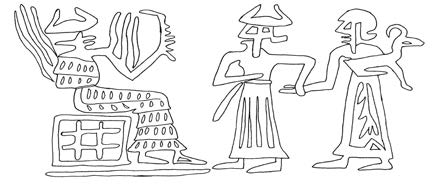
Figure 1. Akkadian cylinder seal showing a presentation scene, ca. 2300 bc. An interceding deity leads a supplicant by the hand into the presence of the sun god Shamash; the supplicant holds a caprid to present as an offering. Redrawn by the author from Henri Frankfort, Cylinder Seals: A Documentary Essay on the Art and Religion of the Ancient Near East (London: Macmillan, 1939), pl. 18e.
A similar kind of scene is found in Egyptian art of the New Kingdom, featured on the walls of royal tombs, in temple reliefs, and in vignettes from Spells 117 and 125 of the Book of the Dead. In these Egyptian examples, the king or deceased person is inducted by one or more deities into the presence of another deity (see Figures 2–3). Together with these induction scenes in Egyptian art, we find scenes in which the god who stands in front of the king and holds his hand faces him instead of leading him by the hand. Variations of these Egyptian scenes are very commonly found on scarab seals from the Levant during the same time period. Othmar Keel compares the presentation scene in Mesopotamian art and the induction scene in Egyptian art to biblical passages that mention the divine handclasp, but ultimately he rejects this connection because it is hard to reconcile with the Bible’s monotheistic viewpoint.21 In addition, the kind of handclasp shown in the presentation and induction scenes does not seem to fit with the biblical descriptions, in which the right hands of both parties are used.
We have already mentioned the Hittite relief of Tudkhaliya IV from Yazilikaya (see Figure 4). This seems to be the preferred comparandum to the biblical divine handclasp for those who have studied this gesture most closely, namely Eaton and Keel. However, once again, note that the god uses his left hand, not his right, to grasp the king’s right hand. This does not match the biblical descriptions, in which it is clearly the god’s right hand that is used. Further, we have shown that the idea of leading by the hand does not seem to be a major aspect of the biblical divine handclasp.
[Page 44]
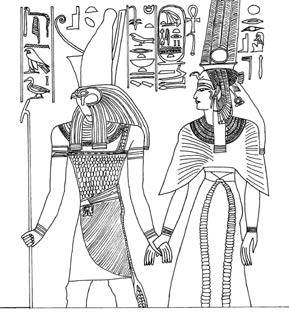
Figure 2. Scene from the tomb of Nefertari, Thebes, ca. 1200 bc. The god Horus, son of Isis, leads the queen Nefertari by the hand into the presence of the deities Re-Horakhty and Hathor. Redrawn by the author from Zahi Hawass, The Royal Tombs of Egypt (London: Thames and Hudson, 2006), 256.
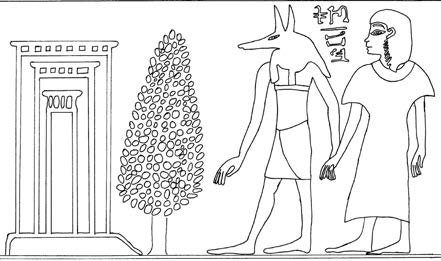
Figure 3. Vignette from the Book of the Dead, Spell 117. The god Anubis leads the deceased person by the hand toward a false door that leads to the presence of Osiris. From the papyrus of Nakht (BM 10471). Redrawn by the author from Raymond O. Faulkner and Carol Andrews, The Ancient Egyptian Book of the Dead (Austin: University of Texas Press, 1990), 112.
[Page 45]
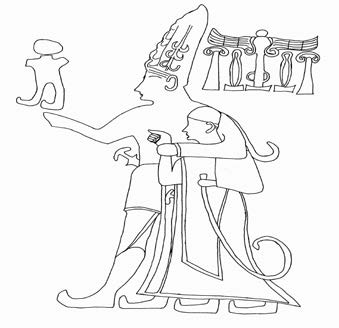
Figure 4. Relief of Tudkhaliya IV from Yazilikaya, ca. 1250 BC. Redrawn by the author from James B. Pritchard, The Ancient Near East in Pictures Relating to the Old Testament (Princeton, New Jersey: Princeton University Press, 1954), 182.
Those who have sought iconographic parallels for the biblical divine handclasp have generally turned to the art of Israel’s neighbors in Mesopotamia, Egypt, and Anatolia. This is certainly better than, say, a comparison with Chinese or Greek art, yet it is not fully satisfactory either, since there are significant cultural and religious differences between Israel and her Near Eastern neighbors. Therefore, we have good reason to ask if there are any depictions of handclasps that are closer to the Israelite context. In fact, there are. A couple of cylinder seals from the Middle Bronze Age Levant22 and assorted scarab seals from the same period23 show a handclasp exchanged between a divine personage and a mortal (see Figure 5). In addition, a Phoenician ivory fan handle from the Iron Age24 shows a handclasp exchanged between a divine personage and a mortal (see Figure 6).
Interestingly enough, the parties of the gesture in all these instances are facing each other. I am not aware of any Levantine art showing the motif of leading by the hand other than the New Kingdom scarabs mentioned earlier, which are more closely tied to Egyptian artistic conventions.
[Page 46]
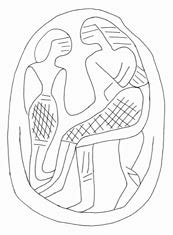
Figure 5. Hyksos scarab seal showing a figure seated on an animal-legged throne, clasping hands with a standing figure. Redrawn by the author from Fiona V. Richards, Scarab Seals from a Middle to Late Bronze Age Tomb at Pella in Jordan (Fribourg: University Press, 1992), pl. 3.
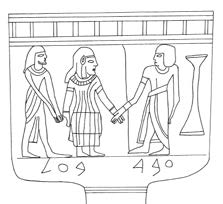
Figure 6. Phoenician ivory fan handle. A figure on the right (possibly a deity or a priest) clasps hands with a man (possibly Abdibaal, the owner of the fan, whose name is given in the inscription at the bottom) across what appears to be a curtain or veil. On the left is an attendant. The incense altar at the far right indicates that the scene takes place at the temple. Redrawn by the author from Karl P. Katz, P. P. Kahane, and Magen Broshi, From the Beginning: Archaeology and Art in the Israel Museum, Jerusalem (New York: Reynal and Company, Inc., 1968), 76.
One may, of course, object that the confronted figures in these Levantine examples are clasping adjacent hands, the left hand of the figure on the left and the right hand of the figure on the right. Thus, on the surface, this does not seem to fit precisely with the biblical descriptions. [Page 47]However, it is quite likely that Levantine iconography depicts the figures in this way for compositional reasons, so that each figure is presented to maximum advantage.25 Similar rearrangement of figures frequently occurs in Egyptian art as well, so it is often difficult to tell which hand would have been used in a given ritual.26 In this case, we can guess that this kind of rearrangement is at work, since there is a discrepancy between the artistic motif and how people actually clasp hands when they face each other in ritual contexts.27 Therefore, we may posit that what is shown for compositional reasons as a clasping of adjacent hands would have transpired in real life as a clasping of right hands. This small assortment of Levantine pieces thus provides a suitable parallel for the biblical descriptions of the divine handclasp.
Implications for the Meaning of the Gesture
In conclusion, let us see what our findings imply about the meaning of the divine handclasp in the biblical world. In the beginning, I mentioned that Eaton and Keel assume that this gesture was a form of leading by the hand. However, our study shows that what we have here is quite different. Since the parties of the gesture would likely face each other, transport could not have been an integral aspect of the gesture, except in the limited sense of one party pulling the other inward. The Psalmist’s statement that God will “receive [him] to glory” in Psalm 73:23–24 can be understood in this latter sense. As we have seen, the idea of “guiding” in connection with this gesture in the Psalms may be interpreted in the sense of giving instruction. In Isaiah 45:1, it is likely a matter of God granting access to His chosen rather than transporting him.
The form of the gesture, with both parties facing each other and clasping right hands, is compatible with the idea that the divine handclasp was performative in nature; in other words, doing the gesture was like saying, “I hereby …” or “I now officially….” It was therefore similar to raising the hand with the palm forward, another gesture that is performed by deities in the Hebrew Bible and in Levantine art. Both the divine handclasp and the raising of the hand sometimes accompany oaths, as in Isaiah 45:1 and Jeremiah 31:31–32. However, the handclasp was different from raising the hand in that the former apparently imparted a special status to the recipient, a status like that of a privileged servant or close family member, as seen almost universally in the passages I have cited.
As mentioned above, Eaton and Keel have maintained that the divine handclasp was part of a temple coronation ritual. The Phoenician ivory [Page 48]fan handle, which shows a god or priest reaching across what appears to be a curtain or veil, may suggest this kind of temple context. However, the precise ritual here is quite different from what Eaton and Keel envisioned; it is more in harmony with the concept of Matt Brown, who drew on late antique and medieval depictions of assumption in which God grasps the hand of a mortal as if to pull him in.28 What I have been able to glean from the Hebrew texts and from Levantine iconography thus confirms what Matt Brown, with his characteristic insight, had already put forward.



Go here to see the 2 thoughts on ““The Divine Handclasp in the Hebrew Bible and in Near Eastern Iconography”” or to comment on it.